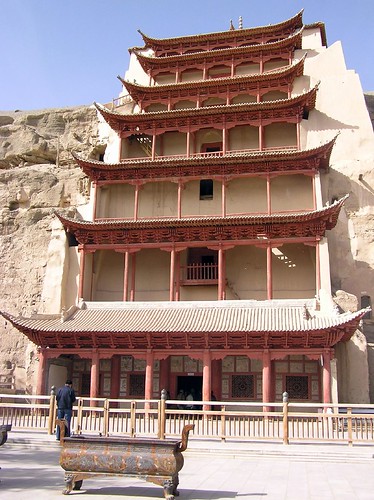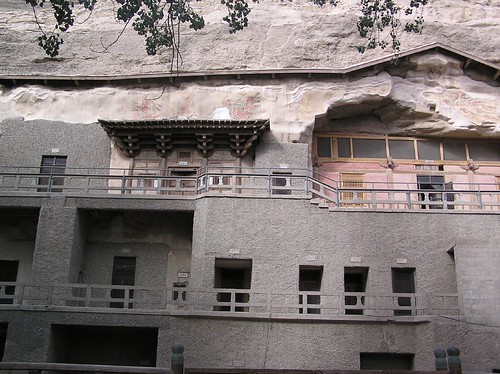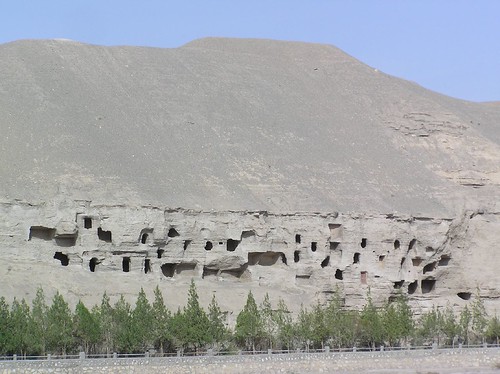| Thursday, November 08, 2007 |
| The China Chronicles - The Mogao Grottoes |
Sometimes a journey arises out of hope and instinct, the heady conviction as your finger travels along the map: Yes, here and here...and here. These are the nerve-ends of the world...
A hundred reasons clamor for your going. You go to touch on human identities, to people an empty map. You have a notion that this is the world's heart. You go to encounter the protean shapes of faith. You go because you are still young and crave excitement, the crunch of your boots in the dust; you go because you are old and need to understand something before it's too late. You go to see what will happen.
Yet to follow the Silk Road is to follow a ghost. It flows through the heart of Asia, but it has officially vanished, leaving behind it the pattern of its restlessness: counterfeit borders, unmapped peoples. The road forks and wanders wherever you are. It is not a single way, but many: a web of choices.
---- Colin Thubron "Shadow of the Silk Road".
This sentiment pretty much sums up my feelings when I was first offered the opportunity to travel this part of the world. What kid hasn't read the Travels of Marco Polo and wanted to run away from home to explore distant lands and far off adventures?
Our trip started with an early morning flight out of Beijing northwest to the oasis town of Dunhuang in Gansu province. At one point, Dunhuang was the most western point in China, and the end of the Great Wall. A pioneer desert outpost along the Silk Road. To there, merchants and traders arrived near death after trekking the 1,500 miles east from Kashgar to skirt the Taklamakan or Gobi Deserts. The Taklamakan, known in China as "Lishuan", or "Flowing Sands" is the second largest desert in the world and with its shifting sands, complete lack of landmarks, and no oases, is one of the most formidable places on earth. From there, other traders were loading up on supplies, getting ready to try and survive the same journey back. All I could think of was the desert trading station in Star Wars - Tatooine. Looks just like it.
Once a thriving trading center with over 700,000 people, Dunhuang withered away over the centuries, and now has a population of a little over 100,000. Legend has it that the Buddhist monk, Yuezun arrived in Dunhuang in 366 BC and dug a meditation cave into a cliff outside of town. Over the next 900 years, many more monks and pilgrims, seeking austerity and solitude did the same, creating what is now a UNESCO World Heritage site known as the Mogao Grottoes.
When the Golden Age of Dunhuang ended during the Ming Dynasty around 1000 AD, the monks inexplicably built a secret cave to store tens of thousands of manuscripts, documents, and paintings, sealed it up, painted some Bodhisattvas over it and it went unknown for the next 900 years or so.
The Buddhist Abbot Wong at the caves discovered the secret room after an earthquake unveiled it around 1900, and promptly resealed it. About 7 years later, the explorer and archaeologist Auriel Stein arrived following up on rumors about the caves when he was studying the Great Wall, and finagled the Abbot to show him the room. Piled almost ten feet high to the ceiling, and protected from the elements for over 1,000 years, were more than 20,000 manuscripts, paintings, books and tapestries, including the oldest printed book in the world and documents written in languages that don't even exist any more. He did what any good colonial explorer would in those days, and took it all back to London. He was quickly followed by the Russian, French, Japanese and Americans, and before you know it - all gone. Scattered across the world's museums and collector's homes.
Today, only ten of the nearly 500 caves are open to the public, and in 1944 the Dunhuang Academy was built to offer scholars the opportunity to make the study of the caves and their artwork a lifetime's work. Slowly, many of the most valuable original manuscripts are being repatriated to China from their adopted homes abroad.
You are prevented from taking photos inside the caves, so my narrative will have to suffice. I did buy a wonderful book on the caves that was put together with a grant from the JP Getty Museum. The colors and details that exist after hundreds, if not thousands of years, are staggering. They mythology and art history would give my art historian sister a dizzy spell. You can't possibly appreciate them without studying them for a bit, and you can't do that on a 2 hour tour.
Scene after scene of paradise, with literally a thousand Buddhas lining every nook and cranny of the cave. Flying gods and musicians telling legends and myths. Wonderfully carved statues and figurines. Hunting parties flying across the walls in search of white tigers and lions. The paintings are remarkably preserved. A red paint that was used for flesh tones has darkened the faces of many of the figures, but the robes and flowers, are still bright and fresh.
The art is a true collage of Chinese, Indian, Tibetan, Persian and Nestorian cultures. It accurately reflects the multitude of cultures and mythologies brought to Dunhuang by visitors traveling the Silk Road for centuries.
Today, it is visited by more than 200,000 people a year, and is truly one of the less known wonders of our time.
Here's a view of the Grotto entrance. Behind this edifice, is a 200 foot statue of a seated Buddha.

This is the public portion of the caves:

But as you drive along, you can see the scope of the entire complex:

Next up - a Little Camel Riding in the Gobi |
posted by Broadsheet @ 11:24 AM   |
|
| 1 Editorial Opinions: |
-
That is fascinating stuff. Thanks so much for sharing that!
|
| |
| << Home |
| |
|
|


That is fascinating stuff. Thanks so much for sharing that!